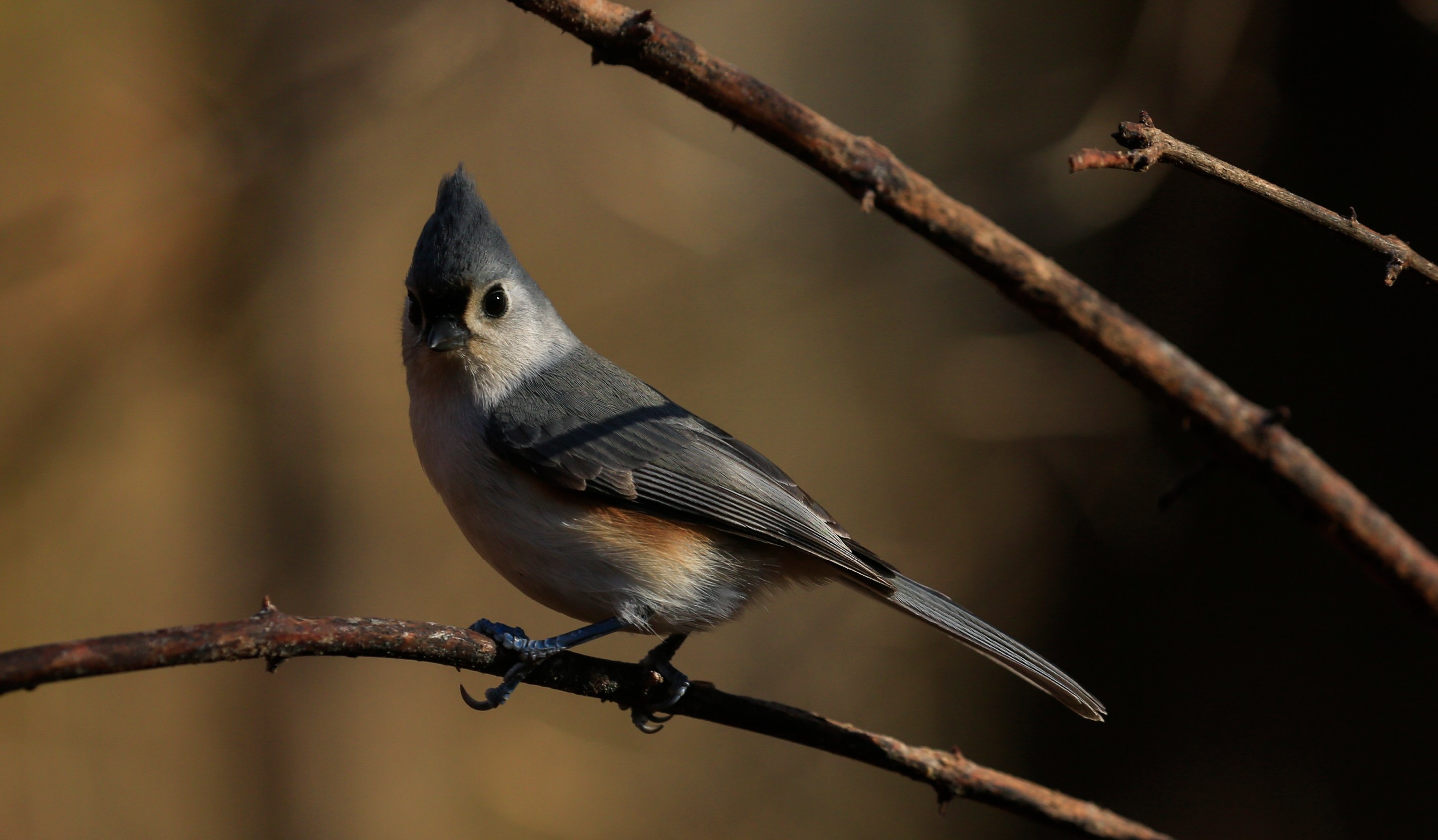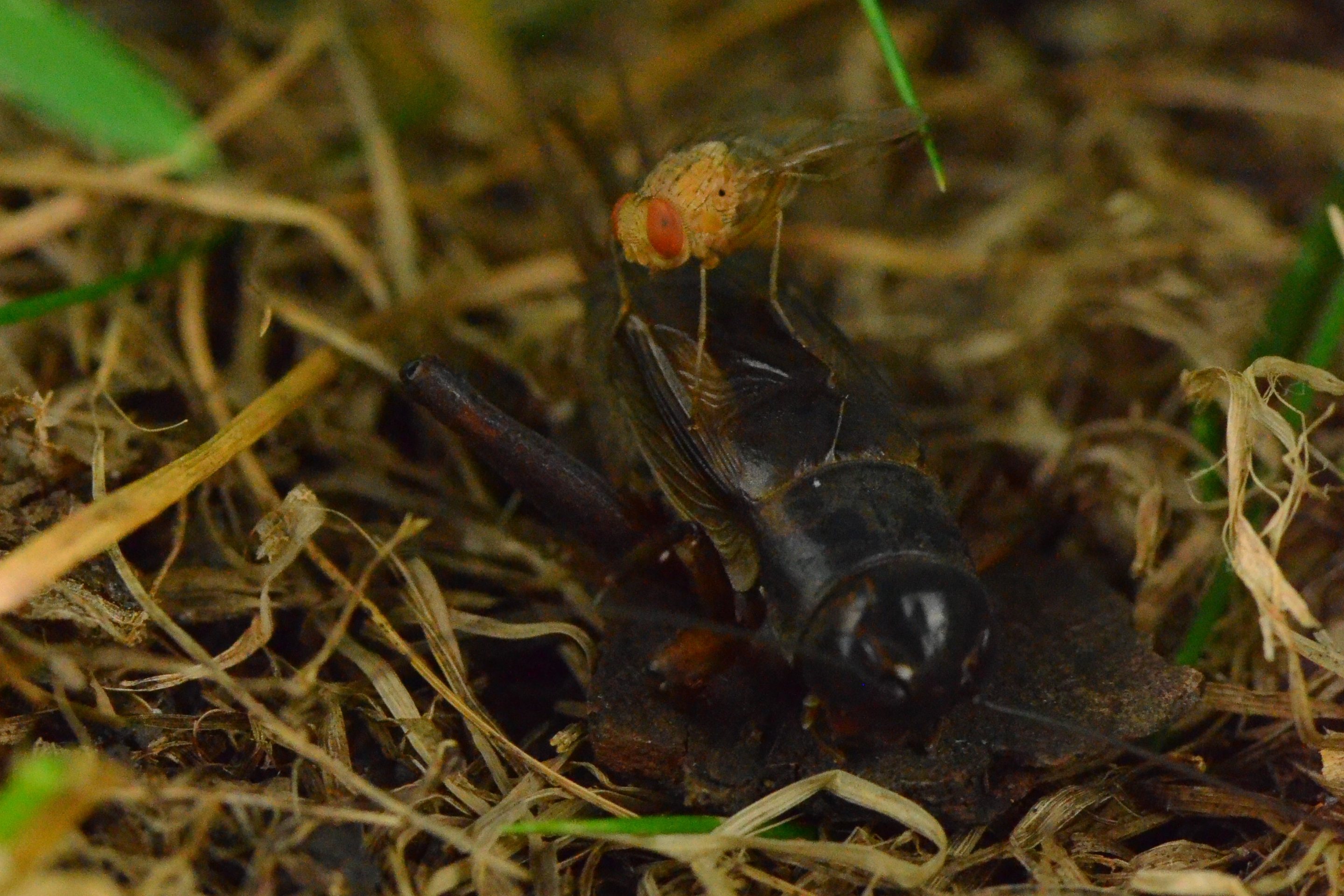A Bird Idiot’s Guide To Birding
1:18 PM EST on March 3, 2021

A tufted titmouse, the tiny bird king of winter.
A garden shop near my home has “THINK SPRING!” in plain black capitals on its letter board, and I am trying, man. I note the extra minutes of sunlight tacked on to each passing week. I look at the snow outside—always more falling before the previous drifts melt—and know that daffodils will soon poke through. In a few weeks I will put my parkas in storage and pull out my lighter coats, and robins will once again hop in the grass, pausing to listen to the damp earth.
The robins aren’t gone, by the way. Many don’t migrate at all. They roost in trees, eating berries. I had never seen them in winter—had never thought about them in winter, really—until I started looking, and now the proverbial “first robin of spring” has new meaning. It is not some traveler returning from a winter vacation in the tropics, but a hardy soul who has hunkered down to survive the cold and darkness, just like me and you. The robins are there all along, thinking spring.
Every season is a good season to look at birds, but spring is especially good. All of the migratory species that flew away to Central and South America for the winter fly back here to mate, and breeding adults sport their brightest, sexiest feathers. Across most of America, the diversity and vibrancy of birds is unmatched for the rest of the year. If you are not a birder but would like to be one, spring is a wonderful time to start. So the time to get ready is now.
I know, I know: starting something, UGH. The prospect of a new habit—a full-ass year into a pandemic that has killed half a million Americans and kept you more or less barricaded inside your home—probably looks like El Capitan from the foot of the Dawn Wall. I cannot blame you if the only new thing you want is a gritty reboot of Victorian England on a streaming TV service. The algorithms are powerful indeed.
But not as powerful as the call of the outdoors, especially if you’ve been stuck indoors. About two years ago, I moved away from my longtime home of New York City to Connecticut. Not the wealthy kind of Connecticut to be despised and envied, or even the kind of Connecticut that provides Metro-North train access to NYC. I live in the central Connecticut of Lyme disease and abandoned mills, a place where sports bars have both Red Sox and Yankees logos lit up in neon. In response to losing the hum of the city (sirens at all hours and hurling obscenities at cab drivers), I have gone the other way entirely: walking alone in forests as often as possible for as long as possible.
The claustrophobic anxiety of the pandemic has played a role, as it has for many other new birders. Last spring and summer, when everyone was losing their minds from the quarantine and the election and getting shot by police and protesting getting shot by police, I found relief in the parabolic flight of goldfinches. I bought some binoculars a few weeks later, and now here I am, birding and writing about it. What a journey.
You needn’t upend your life to look at some nice birds, though; birding is incredibly easy to pick up. It’s not like working out, where you get bad at it if you stop for a while. It’s not a multi-month commitment of progressively harder and more time-consuming obligations, like training for a marathon. It is literally looking at and identifying birds. You can do it once a year or multiple times per day. You can search the globe (once travel is safe again) or watch from your kitchen window. Go full bird-brain or stay a casual feather jockey; whatever you do, you’ll never get worse. The stakes are always low. And since the socio-political climate of the pandemic feels like a Sword of Damocles that falls if I stop yelling to take a breath, any real-world activity with low stakes feels glorious.
All you need to get started are two things:
- Binoculars
- The Merlin Bird ID app or a field guide
OK, yes, technically you also need birds. But if I were writing a how-to guide for hiking, I would not tell you to pack a mountain. So: just the binos and the app. If there’s a birding explainer on the internet that says you need more than two things, you are being hustled!
Binoculars
MANDATORY. I use the Nikon ProStaff 3GS ($129), which were recommended to me by this site’s Albert Burneko (also a Bird Guy). They are waterproof, light enough to hold with one hand for long periods, and feature adjustable eyecups for glasses-wearers. According to some people who review binoculars online, the image the Nikons produce is on par with more expensive, heavier binos. I wouldn’t know!
If that price is prohibitive, or if you demand only the FINEST field glasses, you can find the right price point for your budget. Wirecutter recommends some options in the $300 range, but I also saw some binos for $12 in CVS the other day. You can buy a monocular that fits onto your iPhone—great for taking photos—for less than what my ProStaffs cost. Buy Jack Sparrow’s telescope for all I care! The important thing is that you have a device that is conceptually “Eyes, But Closer.”
Once you have binoculars, a whole new world opens up. The small brown bird in low light on the ground 25 yards in front of you is no longer “probably some sparrow” but “Oh, a tufted titmouse!” It is not brown at all, but bluish-gray, with rufus patches under its wings, a handsome crest on its head, and the bright black eyes of a child’s stuffed animal. All around you, your surroundings will become more lively, more alive. Those silhouettes in the sky, the anonymous monochromatic flitting, the background animation of your life: It all comes rushing into vivid variegated focus with binoculars.
Back in December, while trudging through the woods on a bitter gray day, I saw a brown lump in a tangle of bare branches, backlit by the low winter sun. It was mottled like bark, in every way part of the tree except for its boxy shape. I put the binoculars to my eyes and it became a barred owl, its brown eyes observing me without fear. The bars of brown and white feathers were handsome and soft-looking, but when I pulled the binos down, their purpose was clear: The owl melted back into the tree. Even from 10 yards away, the raptor was essentially invisible to the naked eye. I had never seen an owl in the wild before, and everything about it—its size, its camouflage, its insouciant disregard for my presence—inspired in me the kind of awe and wonder about the natural world I’ve only felt when flying over the Rockies or visiting national parks.
That feeling is now something I experience several times a week. It’s there when I wrench the car to the shoulder to look at a red-tailed hawk perched high above the road. (I, uh, maybe keep the binoculars on the passenger seat when I drive.) It gives me ballast against seasonal depression when I see a cardinal or bluebird pop against a background of snowy branches. And I get a twist of animal fear when I see a great blue heron in detail: The terrible yellow eyes, the stiletto of a head atop a coiled neck like a harpoon to be launched; it is a flying murdersaurus with a six-foot wingspan that somehow only weighs five pounds, AND it has decorative eyebrow feathers like it’s Stanley Tucci in The Hunger Games. And you’re just gonna, what—look at it from afar, with your shitty human eyes? Get some damn binoculars!
The Merlin Bird ID app
Once you can see the birds, you must then figure out which birds they are. In olden days (about seven years ago), you had to carry a big-ass field guide and haphazardly flip through hundreds of pages to figure out what kind of bird you just saw. No longer! The Merlin app, created by the Cornell Lab of Ornithology, is a free download for iPhone or Android, and it asks you a simple series of questions—location, date, size of the bird (you select on a range from sparrow to robin to crow to goose), color, and activity (flying, swimming, stealing fries on the boardwalk, etc.)—before spitting out a list of birds it could be. Tap on a choice, and it gives you more information that you can use to identify your bird: songs and calls, photos, behavior, problematic Twitter likes, etc.
That extra information has frequently been a comfort to me, an unseasoned birder navigating the hobby mostly alone. Before I downloaded Merlin, I had never seen a yellow-rumped warbler or a northern parula. I had never, in fact, heard of them until Merlin listed them as possibilities for what I was looking at. In that context—trying to match a bird you’ve glimpsed for the first time to pictures of birds you’ve never heard of before—the additional clues about behavior can be the clincher.
Last fall I spotted some juvenile cedar waxwings atop some distant trees, and while adults have a distinct eye mask and pops of color, juveniles are drab and more difficult to identify at long range. Enter Merlin: “Usually in flocks in open woods and edges of woodlands. Often perches in tops of leafless trees.” I read that while standing at the edge of woodlands, looking at birds in the tops of leafless trees, and it provided the confirmation I couldn’t get with my eyes alone.
I should note that Merlin is designed for beginner to intermediate birders, and although it is excellent for most identification, it can sometimes lead you astray if you’re lucky enough to spot a rare species. I saw two wild turkeys last November, and Merlin didn’t offer up the species as an option because not enough turkey sightings had been logged in my area to make them a likely occurrence. HOW DARE THEY!
Should you find your skills starting to eclipse Merlin’s utility, it may be time to add eBird, another free app designed by the Cornell Lab, that is designed for more advanced birders: It allows you to create checklists of birds you’ve seen and keeps track of all your sightings. (Not that you have to choose one app or the other: Your email links your Merlin and eBird accounts, so anything you identify on Merlin is logged on eBird.) If you choose to make your account public, other people can see your checklists and photos of birds, and you can appear on rankings of people who have seen the most bird species. Some people want social or competitive aspects to their hobby; I am not one of those people. Leave me alone! I’m logging scientific data for a laboratory!
When and where to bird
You have surely been woken by birds at dawn before, so you already know that birds are most active in the morning. Thus, morning is the best time to go birding. Some birders—the good ones, probably—would suggest you rise at daybreak to optimize your birding experience. I will do no such thing.
By all means, seize the dawn if you’re a morning person. But also, remember that this is a low-stakes hobby. I’m trying to lower my anxiety and blood pressure, not make a sequel to The Big Year. You can get to the woods at 8 a.m. and still see birds. 9 o’clock? Still birds. 10 o’clock? Look, birds don’t use clocks. Just do your birding before brunch hours.
Depending on where you live, you may not even have to leave your home to bird. The Birdfector staff has already provided hearty and correct takes on bird feeders and the right way to stock them, and I encourage you to follow their advice. Most birds live on a tightrope between starvation and predation, so feeding them eliminates one of the two great stresses of their lives. Not only do birds enjoy having food and being unaware of you; they prefer it to you clomping around their habitat, an action that I will nonetheless recommend in the coming paragraphs. Life is short and pleasures too few; get a birdfeeder and watch the birds with your morning coffee.
Alas, many of us have homes that are not conducive to hanging bird feeders. Perhaps you live on the 10th floor of an apartment building, and your windows don’t open more than two or three inches for legal reasons. Perhaps you live in a Manhattan studio, and a board with exposed nails outside your window is the only thing that prevents pigeons from pooping and cooing and copulating inches from where you sleep (this studio costs $2800/month). Maybe, just maybe, you live in an uptight condo community that forbids bird feeders because “they attract bears,” a rule that several households ignore, but which you cannot because you live next door to the busybody retiree who is president of the Homeowner Association. These strictly hypothetical situations could apply to anyone. Anyway, I can’t have a feeder, so I go to the birds.
Good thing you can find birds anywhere! I recommend any large park or, preferably, a good ol’ forest with trails. A forest, to me, is already a calming place, so even the least successful birding trip is still a walk in the woods. A walk in the woods, though, isn’t as enjoyable without birding. The difference is in the act of paying attention—not just being among the trees, but searching them. Birding gives me a greater awareness of the height and depth of the forest. I pay attention to where I step, scan the underbrush close to me, move my gaze to lower branches in the near and middle distance, then to treetops as far out as I can see. Then I crane my neck up to sweep back along the treetops directly above me and begin again. I’m attuned to any flitting movement and the sound of birdsong, of course, but I also look for clues in the forest: woodpecker holes on dead and dying trees; lusher thickets that suggest a streambed; berry bushes that attract songbirds.
You can also, I suppose, NOT treat birding like you’re on patrol in the Mekong Delta. Sometimes I don’t realize my mind is wandering among the towering red pines, and I stop, look around, and wonder how far I’ve walked without paying attention to anything around me. It’s the same feeling as reading all the words on a page and retaining none of it. And that’s fine! Unlike a book, you don’t have to go back. Again: low stakes.
Low stakes, though, don’t mean meager rewards. Sometimes I log a new species I’ve never seen before; this can be revelatory—as with the barred owl—or rudimentary, like when I distinguished a fish crow from the American crow by its call. Sometimes I only see the same birds I’ve seen for weeks on end (this is especially true in winter), but I never tire of seeing the same birds; with repetition I can better identify taxa by call or song, by profile or flight. Occasionally I see a familiar bird in a unique way: Once, two pileated woodpeckers fell from a tree 10 yards in front of me while fighting in mid-air; another time, I saw a great blue heron jettison a stream of liquid shit reminiscent of a spring break bender. And sometimes—not often, but sometimes—the woods are still and silent, and all I do is shuffle through dry leaves in diagonal autumn light. The worst-case scenario is lovely.
But that problem, if you can even call it one, is still months away. You will never want for birds in springtime. They will come up from the tropics, and they will come down from the trees, and your world will be brighter and lighter for it. Don’t just think spring; go out and witness it.
If you liked this blog, please share it! Your referrals help Defector reach new readers, and those new readers always get a few free blogs before encountering our paywall.
Stay in touch
Sign up for our free newsletter




